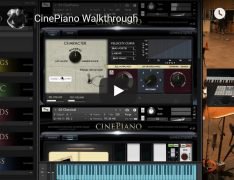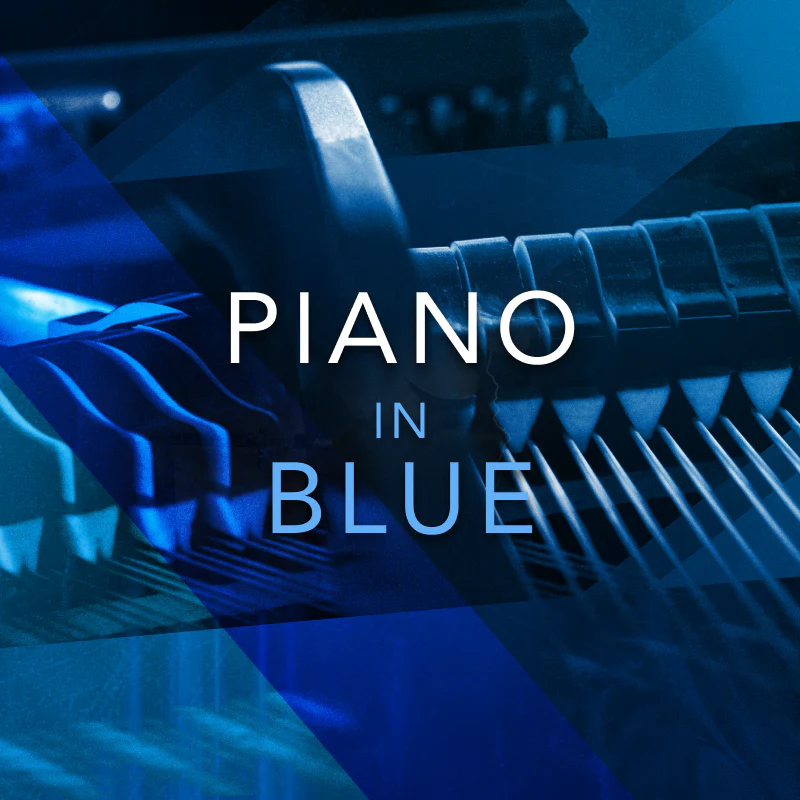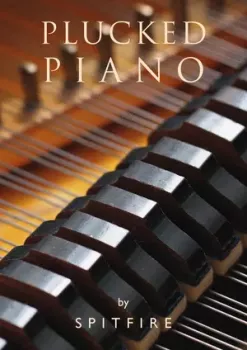CinePiano是我们受欢迎的Blue库中的Piano的现代化后续产品。在洛杉矶索尼电影制片厂的米高梅计分舞台上,手工演唱的三角钢琴被采样了,我们使用了相同的录音和采样技术以及来自蓝色钢琴的许多相同的麦克风。 CinePiano具有四个不同的声音特征,将成为您用途最广泛的钢琴库。
我们如何遵循《蓝色钢琴》这样的行为?我们在洛杉矶索尼影业(Sony Pictures Studios)的米高梅(MGM)评分舞台上录制了令人惊叹的9英尺三角钢琴。我们的目标是在与旗舰CineSymphony库相同的评分阶段记录详细的钢琴库,以实现无缝集成,并通过各种麦克风和混合技术为钢琴提供四个不同的字符。
蒂姆·斯塔恩斯(Tim Starnes)谈录音过程:
“ Piano In Blue的录音效果非常好,我回到了老式的Neumann M49麦克风对及其在PIB上使用的位置。M49由一对Neve 1073前置放大器供电,以模仿录制PIB的Neve 8078调音台就像在PIB上一样,我在钢琴尾部附近放置了一对小型胶囊电容麦克风,除了标准房间阵列外,Adam还放置了其他几对靠近麦克风以提供其他字符选项,这四个唯一字符派生了来自这些各种麦克风以及随后的混合过程。”
4个唯一字符
电影钢琴
这是使用M49和房间阵列在计分阶段上的三角钢琴的标准表示。此贴片提供单独的关闭,房间和环绕麦克风混音。
古典
Classical混音是稍远一些的混音,采用了不同的麦克风组合,专为音乐会现实而设计。这是一个非常特定的组合,因此是此修补程序中唯一可用的组合。
电影的
Cinematic混音是一种非常亲切且柔和的声音,非常适合于电影纹理。这种混音是由一套完全独特的麦克风和混音技术制成的。这是一个非常特定的组合,因此是此修补程序中唯一可用的组合。
大摇滚工作室
Rock Studio Grand更加依赖于混合技术来获得明亮,有力,前卫的声音,并略微失真,以切入大量混音。这是一个非常特定的组合,因此是此修补程序中唯一可用的组合。
特征
透视推子
与CineHarps一样,CinePiano包括一项新的“透视模式”功能,该功能允许通过麦克风位置进行更改。激活“透视模式”时,将出现一个滑块,可在麦克风透视之间进行平滑的淡入淡出。滑块会自动映射到“调制轮”,从而可以立即控制CinePiano的相对深度。
踏板行为-令人振奋
我们向CinePiano添加了一个名为“踏板行为”的新功能。当您在延音踏板向下的情况下在真实的三角钢琴上弹奏音符时,快速释放并踩下延音踏板将使阻尼器没有足够的时间来阻止琴弦完全振动。 CinePiano有效地对这种行为进行建模,以获得更加逼真的效果。
字符
字符旋钮用作宏旋钮,一次控制多个参数。这可用于将游戏风格从亲密变为积极,介于两者之间。设置为亲密时,速度会偏向较低的动态范围,具有较低的动态范围(请参见下面的“动态范围旋钮”)。
音板
音板功能模拟了音板和其他琴弦的共鸣。该效果仅在延音踏板踩下时才有效,可以通过按电源按钮将其关闭。
启用fff层
启用fff图层按钮启用和禁用最高录制的动态。
动态范围
动态范围旋钮的作用有点像MIDI控制的压缩器。该旋钮不会影响力度,而是会改变每个音符的实际音量。较低的值会减小最柔和的动态效果之间的音量差异,而较高的值会增大此差异。
轮循借款
RR借用旋钮将周围的音符用作附加的循环演奏。值为6时,借贷最高可达+/-三音,每个音符最多可提供12个轮询。零值仅在每个动态级别播放一次循环。较高的值会导致更多的轮询和更多的色调变化。默认值为0。
速度曲线
速度曲线控件可用于精确输入您要寻找的动态。 Bias Forte使得更容易演奏大声的动态效果,而Bias Piano则使演奏柔和的动态效果更容易。线性允许速度不受影响地通过。 Velocity Curve控件还可以用来补偿MIDI键盘的硬或软动作。您可以通过单击并拖动鼠标来自定义绘制速度曲线。
释放和踏板音量
这两个推子控制释放样本的音量和踏板上/下音量
CinePiano is the modern follow-up to our popular Piano in Blue library. A Concert Grand Piano sampled by hand at the MGM Scoring Stage at Sony Pictures Studios in Los Angeles, we applied the same recording and sampling techniques and many of the same microphones from Piano in Blue. With four distinct sonic characters, CinePiano will be your most versatile piano library.
How do we follow an act like Piano In Blue? We record a stunning 9′ grand piano at the MGM Scoring Stage at Sony Pictures Studios in Los Angeles. Our goal was to record a detailed piano library at the same scoring stage as our flagship CineSymphony libraries for seamless integration and to provide four distinct characters of the piano through a variety of microphone and mixing techniques.
Tim Starnes on the recording process:
“The recording for Piano In Blue worked so well, I returned to the vintage Neumann M49 microphone pair and its position that I used on PIB. The M49s were powered by a pair of Neve 1073 pre amps to imitate the Neve 8078 console that recorded PIB. Also as on PIB, I placed a pair of small capsule condenser microphones near the tail of the piano. In addition to the standard room array, Adam placed several other close microphone pairs to provide options for other characters. The four unique characters are derived from these various microphones and the mixing process that followed.”
4 UNIQUE CHARACTERS
CinePiano
This is a standard representation of the grand piano on the scoring stage employing the M49s and the room array. The separate close, room, and surround microphone mixes are available on this patch.
Classical
The Classical mix is a slightly more distant mix employing a different combination of microphones and designed for concert realism. It is a very specific mix and thus the only available mix in this patch.
Cinematic
The Cinematic mix is a very intimate and muted sound, perfect for cinematic textures. This mix is made from a completely unique set of microphones and mixing techniques. It is a very specific mix and thus the only available mix in this patch.
Rock Studio Grand
The Rock Studio Grand relies more heavily on mixing techniques to achieve a brighter, punchy, edgy sound with a slight distortion on the attacks to cut through a heavy mix. It is a very specific mix and thus the only available mix in this patch.
FEATURES
The Perspective Fader
CinePiano, like CineHarps, includes a new Perspective Mode feature that allows for changes through microphone positions. When you activate Perspective Mode, a slider appears that gives a smooth crossfade between the microphone perspectives. The slider is automatically mapped to the Mod Wheel, giving instant control of the relative depth of CinePiano.
Pedal Behavior – Repedalling
We added a new feature called Pedal Behavior to CinePiano. When you play a note on a real grand piano with the sustain pedal down, quickly releasing and depressing the sustain pedal does not allow the dampers enough time to stop the strings from vibrating completely. CinePiano effectively models this behavior for a much more lifelike performance.
Character
The Character knob acts as a macro knob, controlling multiple parameters at once. This can be used to change the play style from intimate to aggressive and everything in-between. When set to intimate, the velocities are biased towards the lower dynamics, with a low dynamic range (see Dynamic Range Knob below).
Soundboard
The Soundboard feature emulates the sympathetic resonances of the soundboard and other strings. This effect is only active when the sustain pedal is down and can be turned off by pressing the power button.
Enable fff layer
The Enable fff Layer button enables and disables the highest recorded dynamic.
Dynamic Range
The Dynamic Range knob acts a bit like a MIDI-controlled compressor. This knob doesn’t impact the velocities, but instead changes the actual volume of each note. A low value reduces the volume difference between the softest and loudest dynamics, and a high value increases the difference.
Round Robin Borrowing
The RR Borrowing knob employs surrounding notes as additional round robins. A value of 6 results in up to +/- a tritone of borrowing providing up to an additional 12 round robins per note. A value of zero only plays one round robin per dynamic level. Higher values result in more round robins and more tonal variation. The default value is 0.
Velocity Curve
The Velocity Curve control can be used to dial in exactly the dynamic you are looking for. Bias Forte makes it easier to play louder dynamics, and Bias Piano makes it easier to play soft dynamics. Linear allows the velocities to pass through unaffected. The Velocity Curve control can also be used to compensate for a MIDI keyboard with an undesirably hard or soft action. You can custom-draw a velocity curve by clicking and dragging with the mouse.
Release and Pedal Volume
These two faders control the volume of the release samples and pedal up/down volume, respectively.
Requires Kontakt version 5.6.8 or higher
home page
http://cinesamples.com/product/cinepiano







